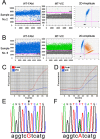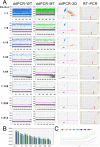IDH1 mutation detection by droplet digital PCR in glioma
- PMID: 26485760
- PMCID: PMC4741852
- DOI: 10.18632/oncotarget.5630
IDH1 mutation detection by droplet digital PCR in glioma
Abstract
Glioma is the most frequent central nervous system tumor in adults. The overall survival of glioma patients is disappointing, mostly due to the poor prognosis of glioblastoma (Grade IV glioma). Isocitrate dehydrogenase (IDH) is a key factor in metabolism and catalyzes the oxidative decarboxylation of isocitrate. Mutations in IDH genes are observed in over 70% of low-grade gliomas and some cases of glioblastoma. As the most frequent mutation, IDH1(R132H) has been served as a predictive marker of glioma patients. The recently developed droplet digital PCR (ddPCR) technique generates a large amount of nanoliter-sized droplets, each of which carries out a PCR reaction on one template. Therefore, ddPCR provides high precision and absolute quantification of the nucleic acid target, with wide applications for both research and clinical diagnosis. In the current study, we collected 62 glioma tissue samples (Grade II to IV) and detected IDH1 mutations by Sanger direct sequencing, ddPCR, and quantitative real-time PCR (qRT-PCR). With the results from Sanger direct sequencing as the standard, the characteristics of ddPCR were compared with qRT-PCR. The data indicated that ddPCR was much more sensitive and much easier to interpret than qRT-PCR. Thus, we demonstrated that ddPCR is a reliable and sensitive method for screening the IDH mutation. Therefore, ddPCR is able to applied clinically in predicting patient prognosis and selecting effective therapeutic strategies. Our data also supported that the prognosis of Grade II and III glioma was better in patients with an IDH mutation than in those without mutation.
Keywords: droplet digital PCR (ddPCR); glioma; isocitrate dehydrogenase (IDH); quantitative real-time PCR (qRT-PCR); sensitivity.
Conflict of interest statement
All authors claimed that there is no conflict of interest.
Figures




Similar articles
-
A novel COLD-PCR/FMCA assay enhances the detection of low-abundance IDH1 mutations in gliomas.Diagn Mol Pathol. 2013 Mar;22(1):28-34. doi: 10.1097/PDM.0b013e31826c7ff8. Diagn Mol Pathol. 2013. PMID: 23370430
-
A novel high-sensitivity assay to detect a small fraction of mutant IDH1 using droplet digital PCR.Brain Tumor Pathol. 2018 Apr;35(2):97-105. doi: 10.1007/s10014-018-0310-7. Epub 2018 Feb 19. Brain Tumor Pathol. 2018. PMID: 29460200
-
Sensitive and rapid detection of TERT promoter and IDH mutations in diffuse gliomas.Neuro Oncol. 2019 Mar 18;21(4):440-450. doi: 10.1093/neuonc/noy167. Neuro Oncol. 2019. PMID: 30346624 Free PMC article.
-
TERT promoter mutation and its interaction with IDH mutations in glioma: Combined TERT promoter and IDH mutations stratifies lower-grade glioma into distinct survival subgroups-A meta-analysis of aggregate data.Crit Rev Oncol Hematol. 2017 Dec;120:1-9. doi: 10.1016/j.critrevonc.2017.09.013. Epub 2017 Oct 3. Crit Rev Oncol Hematol. 2017. PMID: 29198322 Review.
-
IDH mutations in glioma and acute myeloid leukemia.Trends Mol Med. 2010 Sep;16(9):387-97. doi: 10.1016/j.molmed.2010.07.002. Epub 2010 Aug 5. Trends Mol Med. 2010. PMID: 20692206 Review.
Cited by
-
Copy Number Variation and Rearrangements Assessment in Cancer: Comparison of Droplet Digital PCR with the Current Approaches.Int J Mol Sci. 2021 Apr 29;22(9):4732. doi: 10.3390/ijms22094732. Int J Mol Sci. 2021. PMID: 33946969 Free PMC article. Review.
-
IDH1 mutation is detectable in plasma cell-free DNA and is associated with survival outcome in glioma patients.BMC Cancer. 2024 Jan 3;24(1):31. doi: 10.1186/s12885-023-11726-0. BMC Cancer. 2024. PMID: 38172718 Free PMC article.
-
Liquid Biomarkers for Improved Diagnosis and Classification of CNS Tumors.Int J Mol Sci. 2021 Apr 27;22(9):4548. doi: 10.3390/ijms22094548. Int J Mol Sci. 2021. PMID: 33925295 Free PMC article. Review.
-
Detection of PIK3CA Gene Mutation in Head and Neck Squamous Cell Carcinoma Using Droplet Digital PCR and RT-qPCR.Biomolecules. 2021 May 31;11(6):818. doi: 10.3390/biom11060818. Biomolecules. 2021. PMID: 34072735 Free PMC article. Clinical Trial.
-
O6-methyl-guanine-DNA methyltransferase methylation and IDH1/2 mutation in small cell lung cancer.Exp Ther Med. 2017 Jul;14(1):398-402. doi: 10.3892/etm.2017.4476. Epub 2017 May 18. Exp Ther Med. 2017. PMID: 28672945 Free PMC article.
References
-
- Balss J, Meyer J, Mueller W, Korshunov A, Hartmann C, von Deimling A. Analysis of the IDH1 codon 132 mutation in brain tumors. Acta Neuropathol. 2008;116:597–602. - PubMed
-
- Schaap FG, French PJ, Bovee JV. Mutations in the isocitrate dehydrogenase genes IDH1 and IDH2 in tumors. Adv Anat Pathol. 2013;20:32–38. - PubMed
Publication types
MeSH terms
Substances
LinkOut - more resources
Full Text Sources
Other Literature Sources
Molecular Biology Databases
Research Materials
Miscellaneous

